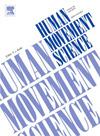Cortical rhythms associated with early postural stabilization during the transition from the double-leg to the single-leg stance
IF 1.9
3区 心理学
Q4 NEUROSCIENCES
引用次数: 0
Abstract
Objective
Previous studies have demonstrated that the cerebral cortex is involved in the postural responses to static standing and disturbances. However, the role of the cortex in postural stabilization remains unclear. This study aimed to clarify cortical activity during postural stabilization.
Methods
Thirteen healthy adult subjects performed a transition from the double-leg stance to the single-leg stance. The tasks were classified as −1–0 s (T1) to 3–4 s (T5), and the relationship between the power spectrum of the alpha and beta bands of the electroencephalogram (EEG) and the center of pressure (COP) or time to stabilization (TTS) was examined. The subjects were also divided into the low-TTS and high-TTS groups based on TTS, and EEG findings were compared between groups.
Results
While COP parameters showed no significant correlation with EEG findings, TTS shortening was associated with a decrease in the alpha power at T2 (0–1 s) and an increase in the beta power at T5. Low-TTS group also showed a decrease in the alpha power compared with high-TTS group. Furthermore, low-TTS group showed an increase in beta power at T5 compared with T1, and high-TTS group showed a decrease in beta power at T5 compared with T3 (1–2 s).
Conclusion
Our findings indicate that the cerebral cortex contributes to faster postural stabilization. Furthermore, the results suggest that the decrease in alpha power is the cortical activity that stabilizes the posture, and the increase in beta power is the cortical activity that maintains a stable posture.
在从双腿站立到单腿站立的过渡过程中,与早期姿势稳定相关的皮质节律
目的以往的研究表明,大脑皮层参与了静态站立和干扰的姿势反应。然而,皮层在姿势稳定中的作用仍不清楚。本研究旨在阐明姿势稳定过程中的皮质活动。方法13名健康成人受试者从双腿站立过渡到单腿站立。将任务划分为- 1-0 s (T1) ~ 3-4 s (T5),并检测脑电图α、β波段功率谱与压力中心(COP)或稳定时间(TTS)的关系。根据TTS水平将受试者分为低TTS组和高TTS组,并比较各组脑电图结果。结果COP参数与脑电图无显著相关性,TTS缩短与T2 (0-1 s)时α功率降低、T5时β功率升高相关。与高tts组相比,低tts组的α功率也有所下降。低tts组在T5时β功率较T1升高,高tts组在T5时β功率较T3降低(1 ~ 2 s)。结论我们的研究结果表明,大脑皮层有助于更快的姿势稳定。此外,研究结果表明,α能量的下降是稳定姿势的皮层活动,而β能量的增加是维持姿势稳定的皮层活动。
本文章由计算机程序翻译,如有差异,请以英文原文为准。
求助全文
约1分钟内获得全文
求助全文
来源期刊

Human Movement Science
医学-神经科学
CiteScore
3.80
自引率
4.80%
发文量
89
审稿时长
42 days
期刊介绍:
Human Movement Science provides a medium for publishing disciplinary and multidisciplinary studies on human movement. It brings together psychological, biomechanical and neurophysiological research on the control, organization and learning of human movement, including the perceptual support of movement. The overarching goal of the journal is to publish articles that help advance theoretical understanding of the control and organization of human movement, as well as changes therein as a function of development, learning and rehabilitation. The nature of the research reported may vary from fundamental theoretical or empirical studies to more applied studies in the fields of, for example, sport, dance and rehabilitation with the proviso that all studies have a distinct theoretical bearing. Also, reviews and meta-studies advancing the understanding of human movement are welcome.
These aims and scope imply that purely descriptive studies are not acceptable, while methodological articles are only acceptable if the methodology in question opens up new vistas in understanding the control and organization of human movement. The same holds for articles on exercise physiology, which in general are not supported, unless they speak to the control and organization of human movement. In general, it is required that the theoretical message of articles published in Human Movement Science is, to a certain extent, innovative and not dismissible as just "more of the same."
 求助内容:
求助内容: 应助结果提醒方式:
应助结果提醒方式:


